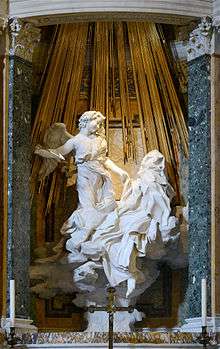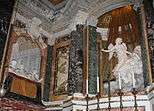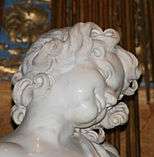Ecstasy of Saint Teresa
 | |
| Artist | Gian Lorenzo Bernini |
|---|---|
| Year | 1647–52 |
| Catalogue | 48 |
| Type | Sculpture |
| Medium | Marble |
| Dimensions | Life-size |
| Location | Santa Maria della Vittoria, Rome |
| Coordinates: 41°54′17″N 12°29′39″E / 41.90472°N 12.49417°E | |
The Ecstasy of Saint Teresa (alternatively Saint Teresa in Ecstasy or Transverberation of Saint Teresa; in Italian: L'Estasi di Santa Teresa or Santa Teresa in estasi) is the central sculptural group in white marble set in an elevated aedicule in the Cornaro Chapel, Santa Maria della Vittoria, Rome. It was designed and completed by Gian Lorenzo Bernini, the leading sculptor of his day, who also designed the setting of the Chapel in marble, stucco and paint. It is generally considered to be one of the sculptural masterpieces of the High Roman Baroque. It pictures Teresa of Ávila.
Commission
The entire ensemble was overseen and completed by a mature Bernini during the Pamphili papacy of Innocent X. When Innocent acceded to the papal throne, he shunned Bernini’s artistic services; the sculptor had been the favourite artist of the previous and profligate Barberini pope. Without papal patronage, the services of Bernini's studio were therefore available to a patron such as the Venetian Cardinal Federico Cornaro (1579–1653). Cornaro had chosen the hitherto unremarkable church of the Discalced Carmelites for his burial chapel.[1] The selected site for the chapel was the left transept that had previously held an image of ‘St. Paul in Ecstasy’, which was replaced by Bernini’s dramatization of a religious experience undergone and related by the first Discalced Carmelite saint, who had been canonised not long before, in 1622.[2] It was completed in 1652 for the then princely sum of 12,000 scudi.[3]
Sculptural group and its setting

The two central sculptural figures of the swooning nun and the angel with the spear derive from an episode described by Teresa of Avila, a mystical cloistered Discalced Carmelite reformer and nun, in her autobiography, ‘The Life of Teresa of Jesus’ (1515–1582). Her experience of religious ecstasy in her encounter with the angel is described as follows:
I saw in his hand a long spear of gold, and at the iron's point there seemed to be a little fire. He appeared to me to be thrusting it at times into my heart, and to pierce my very entrails; when he drew it out, he seemed to draw them out also, and to leave me all on fire with a great love of God. The pain was so great, that it made me moan; and yet so surpassing was the sweetness of this excessive pain, that I could not wish to be rid of it. The soul is satisfied now with nothing less than God. The pain is not bodily, but spiritual; though the body has its share in it. It is a caressing of love so sweet which now takes place between the soul and God, that I pray God of His goodness to make him experience it who may think that I am lying.[4]
The group is illuminated by natural light which filters through a hidden window in the dome of the surrounding aedicule, and underscored by gilded stucco rays. Teresa is shown lying on a cloud indicating that this is intended to be a divine apparition we are witnessing. Other witnesses appear on the side walls; life-size high-relief donor portraits of male members of the Cornaro family, e.g. Cardinal Federico Cornaro and Doge Giovanni I Cornaro, are present and shown discussing the event in boxes as if at the theatre. Although the figures are executed in white marble, the aedicule, wall panels and theatre boxes are made from coloured marbles. Above, the vault of the Chapel is frescoed with an illusionistic cherub-filled sky with the descending light of the Holy Ghost allegorized as a dove.
The art historian Rudolf Wittkower has written:
In spite of the pictorial character of the design as a whole, Bernini differentiated between various degrees of reality, the members of the Cornaro Chapel seem to be alive like ourselves. They belong to our space and our world. The supernatural event of Teresa’s vision is raised to a sphere of its own, removed from that of the beholder mainly by virtue of the isolating canopy and the heavenly light.[5]
- Gallery




Interpretations
The effects are theatrical,[6] the Cornaro family seeming to observe the scene from their boxes,[7] and the chapel illustrates a moment where divinity intrudes on an earthly body. Caroline Babcock speaks of Bernini's melding of sensual and spiritual pleasure in the "orgiastic" grouping as both intentional and influential on artists and writers of the day.[8] Irving Lavin said "the transverberation becomes a point of contact between earth and heaven, between matter and spirit".[9] As Bernini biographer Franco Mormando points out, although Bernini's point of departure for his depiction of Teresa's mystical experience was her own description, there were many details about the experience that she never specifies (e.g., the position of her body) and that Bernini simply supplied from his own artistic imagination, all with an aim of increasing the nearly transgressively sensual charge of the episode: "Certainly no other artist, in rendering the scene before of after Bernini dared as much in transforming the saint's appearance."[10]
Similar works by Bernini
- See also entry titled Bernini's Cornaro chapel found in the Baroque section.
- Death of the Blessed Ludovica Albertoni (1671–74)—San Francesco a Ripa, Rome.
- Martyrdom of Saint Lawrence (1614–15)[11]
- Truth Unveiled by Time (1646–52) – Galleria Borghese, Rome.[12]
Influencing or influenced works
- Stefano Maderno's sculpture of St Cecilia in namesake church (1600).
- Melchiorre Caffà's Santa Rose of Lima (1665) and his Assumption of St Catherine.
- Francisco Aprile and Ercole Ferrata's Sant'Anastasia in her namesake church in Rome.
- The most internationally successful Czech underground group the Ecstasy of Saint Theresa named themselves after the sculpture.
- Angels & Demons, the novel by Dan Brown which lists the sculpture as the third "Altar of Science" of the fictionalized Illuminati.
- The sculpture is the subject of the song "The Lie" from the Peter Hammill album The Silent Corner and the Empty Stage.[13]
- In Infinite Jest by David Foster Wallace, the sculpture plays a role in the filmography of James O. Incandenza, Jr. Wallace also alludes to it in three additional scenes involving Joelle.[14]
- Street artist Banksy used the image of Saint Theresa in one of his works, though he removed the angelic figure and added a fast food meal.[15]
- The sculpture and its image are frequently referred to in the novel Cutting For Stone by Abraham Verghese.
References and sources
- References
- ↑ He had reason to avoid burial in Venice, since his appointment as a cardinal by Urban VIII while his father Giovanni was Doge had created a furor in his home-city, which banned families from holding such powerful positions simultaneously.
- ↑ See Boucher B. p135
- ↑ Corresponding to c. $120,000 Italian Baroque Sculpture : Books : Thames & Hudson
- ↑ Chapter XXIX; Part 17, Teresa's Autobiography
- ↑ Wittkower, Rudolf. Art and Architecture in Italy 1600–1750, Pelican History of Art, 1980, p. 160
- ↑ Thomas H. Greer, Gavin Lewis. A Brief History of the Western World. Thompson 2005 p 392
- ↑ "Bernini, Ecstasy of Saint Teresa". Khan Academy.
- ↑ caroline babcock. "Caroline Babcock". academia.edu.
- ↑ Boucher, B. p138.
- ↑ Franco Mormando, 'Bernini: His Life and His Rome' (Chicago: University of Chicago Press, 2011), 164.
- ↑ "Web Gallery of Art, image collection, virtual museum, searchable database of European fine arts (1000-1900)". wga.hu.
- ↑ Official Site Borghese Gallery Bernini – Truth Unveiled by Time
- ↑ http://www.explosant-fixe.com/miscellanees/the-lie-berninis-saint-theresa-de-peter-hammill/
- ↑ "A Field Guide to Occurrences of Bernini's Ecstasy of St. Teresa in Infinite Jest - Infinite Detox". Infinite Detox.
- ↑ "Banksy". banksy.co.uk.
- Sources
- Hibbard, Howard. Bernini.
- Robert Harbison (2000). "The Case for Disruption". Reflections on Baroque. The University of Chicago Press. pp. 1–32.
- Bruce Boucher (1998). Thames & Hudson, World of Art, ed. Italian Baroque Sculpture. pp. 134–143.
- Bernini biography (click on "Ecstasy of St Teresa")
- A Drawing by Bernini for the Cornaro Chapel, S. Maria della Vittoria Richard Cocke The Burlington Magazine, Vol. 114, No. 833 (Aug., 1972), pp. 550+553 Published by: The Burlington Magazine Publications Ltd.
External links
![]() Media related to Ecstasy of Saint Theresa at Wikimedia Commons
Media related to Ecstasy of Saint Theresa at Wikimedia Commons
|
|